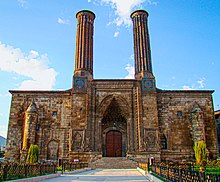Çifte Minareli Medrese, Erzurum
This article relies largely or entirely on a single source. (August 2011) |
| Çifte Minareli Medrese | |
|---|---|
 Twin Minaret Madrasa - Erzurum | |
| Religion | |
| Affiliation | Islam |
| District | Erzurum |
| Province | Erzurum |
| Region | East Anatolia |
| Location | |
| Location | |
| Architecture | |
| Type | Madrasa |
| Style | Islamic, Seljuk architecture |
| Completed | 1265 |
| Minaret(s) | 2 |
Çifte Minareli Medrese is an architectural monument of the late Seljuk period in the Turkish city of Erzurum. Built as a theological school a few years before 1265,[1] it takes its name, Twin Minaret Madrasa, from the two fluted minarets that crown the monumental façade.
History
The Çifte Minareli Medrese is thought to be the model for the Gök Medrese in Sivas.
According to the inscription on the portal, it was built in 1271 by Khudavand Khatun, the daughter of Seljuq Sultan Kayqubad I. XIII. on the half-century after the Seljuk period's cultural life and development activities and is seen as an important circuit. In this century Buruciye Madrasa, Madrasa and Double Minaret Madrasah heavens like stone, brick and tile art of Anatolia, they constitute the most important works.
The east entrance of the madrasa and the enormous stone facade of ornamental brick and tile masonry with two minarets are remarkable. Erzurum, Sivas Gök Medrese with Double Minaret Theological School are learning that similar two-storey building.
Front, middle two minarets, portals, and windows on two sides with corner towers are composed. Is being placed in front of a symmetry between the windows are not decorated.
On each side of the entrance there is a panel. The right side is decorated with a double-headed eagle. The motif on the left side does not seem to be completed.
References
- ^ J.M. Rogers, “The Çifte Minare Medrese at Erzurum and the Gök Medrese at Sivas: A Contribution to the History of Style in the Seljuk Architecture of 13th Century Turkey” Anatolian Studies, Vol. 15. (1965), p. 85.
External links
